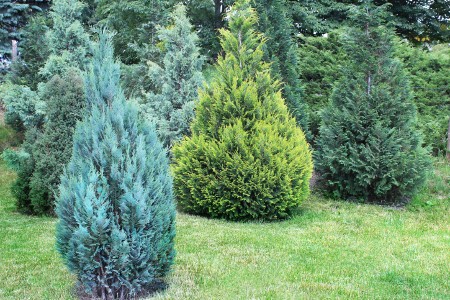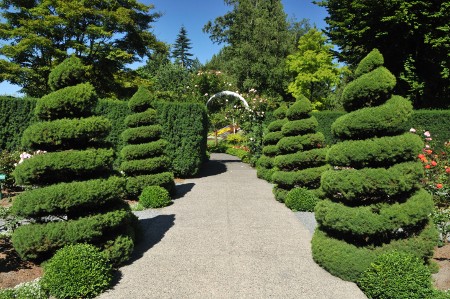The Blue Point juniper tree is one of the more popular additions to a landscape garden. In this Buzzle article we shall look at some Blue Point juniper care instructions and tips on planting, watering, pruning, etc., to help you increase the aesthetic appeal of your garden.

Gardening Tip
While creating a spiral Blue Point juniper tree, cut the bush spirals right to the main trunk for greater emphasis. However, if you desire a more subtle look, gradually decrease the cutting length, as you near the center, without actually reaching the trunk.The bluish green, dense foliage of a Blue Point juniper (Juniperus chinensis) tree, along with its conical shape, give a good contrast to other garden plants, making it a valuable addition to a landscape garden. The dense and wide foliage of Blue Point juniper trees makes them ideal to use as a focal point of the garden or even for group plantings.
They can also be planted in a line, working as a very effective windbreak or used as a privacy screen. This tree is very low maintenance, and unlike other juniper varieties, grows easily in dry and arid areas. Let us look at the requirements of maintaining this plant and keeping it in good health.
How to Plant Blue Point Junipers

Group Planting Blue Point Juniper Trees
Planting a Blue Point juniper tree successfully is not a very difficult task. It can be done by getting a sapling from a nearby nursery or garden center, then going about the following procedure.
- Choosing a Planting Site: The Blue Point juniper is suitable to areas with USDA hardiness zones 3-9. Select a site which has well-drained soil, and is exposed to ample sunlight at least for 6 hours a day. It is recommended that the soil should have a mix of compost and manure, especially if the soil is of a poor quality.
- Planting and Mulching: Dig a hole in the ground with respect to the size of the sapling roots, and carefully place the juniper sapling in it. Cover the roots again with soil, followed by a 3-4 inch think layer of mulch around the base of the plant.
- Watering: During the first year of its growth, water the sapling at the base once or twice in a week, without wetting the foliage, as this may cause diseases. During periods of drought you may have to increase the watering to 2-3 times a week. After the first year, gradually reduce the watering rate. Once the plant is well-established in its area, you only need to water your juniper when the weather is exceptionally warm.
- Fertilizer Usage: Using an organic compost once a month, around the roots, is your best option. You may also use blood or bone meal for this purpose. Alternately, you may use a good water-soluble fertilizer solution. Always water your juniper immediately after fertilization, to get the best results.
- Spacing:The Blue Point juniper will cause problems if grown too close to other garden plants. Ideally, there should be at least a distance of 4 ft between the juniper and any other plant, even if used in group planting.
Other Care Instructions
- Pruning and Trimming : Blue Point junipers usually stay in shape and retain their narrow yet tall form. However, these trees may need trimming or pruning occasionally to tame wayward branches that erupt every now and then. Since most of the nutrients absorbed by the plant go to the ends of the branches, they get longer and heavier, eventually separating from the center of the plant. Prune any excess or dying parts of the plants, and at the same time, use plastic ties to bind the long branches to the center, till they become strong, and hold their position. This process may take at least 2 years to complete. Also, pruning the top ends of the branches, encourages sideways growth, making the plant denser and wider.
- Diseases, Pests, and Other Problems: Blue Point junipers are highly resistant to most animals like deer, and are not very attractive for insect pests either. However, regular inspections should be made for bagworm and spider mite infestations. Those trees which have been over-watered, are at risk of diseases such as kabatina or phomopsis blights. Also, water-logging may cause the roots to rot, and turn the foliage yellow.
The Blue Point juniper has a moderate growth rate, with an increase of 15-20 inches per year, eventually reaching heights of up to 12 feet. Failure to follow the proper planting and care procedures can stunt this growth drastically, and decrease its aesthetic appeal. Let us now look at how one can create a spiral Blue Point juniper, and the measures that need to be taken for maintaining its health and appearance.
Creating a Spiral Blue Point Juniper Tree

Spiral Blue Point Juniper Trees
Blue Point junipers can be pruned in a spiral fashion to create a greater impact in flower gardens, or to create a formal atmosphere when grown in front of a porch. This process is not very difficult for anyone who has a little experience with pruning and shearing. The only equipment you will need is a roll of plant tie ribbon, bypass pruner/ long-handled shears, and topiary shears.
- Tie one end of the plant tie ribbon to the tip of the plant. If there are more than one branches at the apex, tie all of them together and treat them as one.
- Wrap the ribbon around the plant in a downward spiral design, leaving spaces that are around a foot wide, between each spiral. Do this till you reach the bottom of the foliage, and tie the ribbon to a low branch on the juniper. Cut the rest off.
- Now carefully cut out the foliage between the ribbons, using shears or pruners, to create a spiral design. If you wish to have a deep spiral, use bypass pruners to cut the branches right up to the main trunk. Alternately, use the long-handled shears to cut a more subtle wave-patterned spiral into the foliage. Use topiary shears to perfect the pattern.
- The best way to get a good pattern is to cut away at the foliage little-by-little, and step back to check if the appearance of the spiral is how you want it.
Spiral Blue Point Juniper CareA spiral Blue Point juniper needs the same care as a regular one. The only difference would be in the maintenance of the spiral. The tree has to be pruned lightly along its spiral, during spring or early summer, each year. You will also have to regularly check and cut off branches that are out of shape or those that are overgrown and poking out of the spiral.
Obtaining saplings from a good nursery or garden center is very important, as the plant is most vulnerable to climate, pests, and diseases when young. Once your Blue Point juniper is well-established, these trees will grace your garden with their beauty for many years to come.








